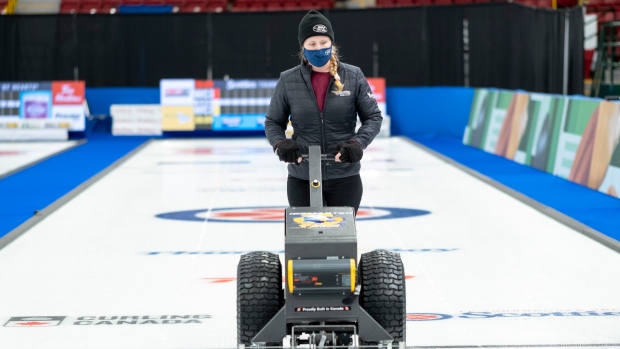Feb 2, 2022
Toronto’s Rebecca Duck making ice and history at the Scotties
Women who make ice in curling clubs are rarities, but this week Toronto’s Rebecca Duck is helping to provide the playing surface at the Scotties Tournament of Hearts at Fort William Gardens in Thunder Bay, Ont. The deputy ice technician on a team of six grooming the ice for Canada’s best female curlers is no stranger to working top events, Bob Weeks writes.
By Bob Weeks

If all the female ice technicians in Canada got together, they’d be able to field just one curling team.
Whether it’s the pay, the hours, the cold working environment or some other unknown reason, women who make ice in curling clubs are rarities. What’s even more uncommon is to have them do it at big events. But this week, one is helping to provide the playing surface at the Scotties Tournament of Hearts at Fort William Gardens in Thunder Bay, Ont.
Toronto’s Rebecca Duck is the deputy ice technician on a team of six grooming the ice for Canada’s top female curlers. While other women have worked on the ice crew at the Scotties, it’s believed this is the first time a woman has held this role at a national championship.
Duck is no stranger to top events, having worked on the Continental Cup and a number of Grand Slam events. Last year, she spent 30 days in the bubble in Calgary, working on the ice for the Tim Hortons Brier and the Canadian Mixed Doubles Curling Championship.
In every step along the way, from club to the national championships, she’s had to prove herself.
“It's just very male-dominated and it can be a little bit intimidating,” said Duck. “I know when I meet a lot of ice technicians that I'm going to be working with, there's a look on their face when they first meet me. It’s kind of like, ‘Oh, OK.’”
But Duck knows her stuff. She’s a second-generation ice technician following in the footsteps of her father, Bill. Her brother, Kyle, is also in the business. She got her start working for her father, running the big lambswool sweeper down the ice to clean the sheets between draws. She enjoyed the work and never left curling.

“I think that my work ethic surprises a lot of the male ice technicians that I meet,” she stated. “I think I get underestimated a lot. And when they realize that I can do just as much as they can, they're pleasantly surprised.”
That was clear last year in Calgary. Danny Lamoureux, Curling Canada’s director of club development and event operations, invited Duck to join the ice team as the first step in a plan to encourage more women to look at the job as a career.
“She got rave reviews from everyone. Clearly she knows her stuff,” said Lamoureux. “Ideally in time, we’d love to make her the chief ice technician at the Scotties.”
Making ice in an arena is far different than at a club. It involves learning the air flow of the building, understanding how the ice plant changes and working with a lot of technical equipment that can lead to a great playing surface.
“Every arena is so different,” stated Duck, who is working under chief ice technician Jon Wall this week. “We try to make the same conditions in every arena and that’s probably the biggest challenge.”
As with last year’s championship, this year’s event is being run without many volunteers. That means the ice technicians are also doing jobs such as emptying garbage cans and vacuuming the carpeted areas beside the ice surface. A typical day for the team starts at 6 a.m. and ends after 10 p.m.
Duck said that other than the odd hello in passing, the players haven’t reached out to her this week. She expects most don’t know that she’s played a large part in giving them excellent playing conditions and making history in the process. Her busy time comes before and after their games so the interactions with the competitors are somewhat brief.
When she’s not scraping and pebbling at the Scotties, Duck is in charge of the ice at Toronto’s Granite Club, the home of the first Brier back in 1927. In addition to looking after the curling ice, she also prepares the surface for figure skating. The Granite is the home to a number of Canada’s top skaters who train and, just like the curlers, are particular about their frozen water.
Being a woman in the business of ice is uncommon but there’s something else that sets Duck apart. At 30, she is also one of the limited number of younger people in the business. The vast majority of technicians are over 50, with a large percentage over 60 and as they head to retirement, their replacements are not knocking down the doors. That’s in part because the job isn’t that easy. Duck estimates an ice technician at a club puts in 60 to 70 hours of work during the curling season. They do get the benefit of having summers off, but many find part-time jobs to supplement the income.
Lamoureux said that Curling Canada is aware of the problem and is taking steps to encourage those looking for work to consider ice making. An educational program is being revamped and a marketing campaign will be released next year.
“The older ice technicians in small clubs are retiring and there’s no one to replace them,” he stated. “In the last couple of years, we’ve had some younger people come into the business. And with Rebecca showing what can be done, we’re hoping women will take it up as well. But we still need more.”
Duck doesn’t see herself as a trailblazer but she does hope more women consider a career as an ice technician. One day, she hopes that the entire crew is made up of women.
“I think that would be great,” she stated.
